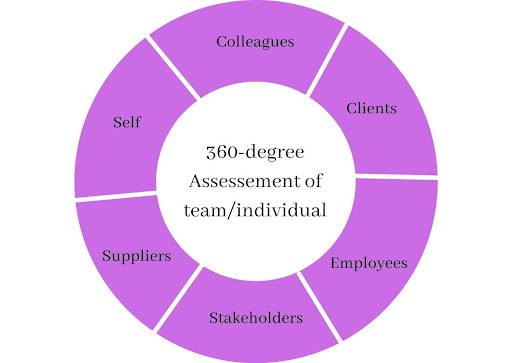360-Degree Feedback: A One-Stop Guide for Easy Implementation
Five key steps for implementing a 360-degree feedback strategy
by Grace Lau, Director of Growth Content at Dialpad - February 11th, 2022
Companies are constantly trying to find ways to improve their performance and ratings. Whether it’s through training, new policies, better communication methods, or new digital customer experience management solutions, there’s always something more that can be done. Surveys and questionnaires are two methods for informing what needs to change (or stay the same).
360-degree feedback is a data-generating method that is more holistic than traditional feedback forms. Instead of focusing on simply employees or customers, 360-degree feedback gathers data from a whole host of different stakeholders.
What is 360-degree feedback?

When you think of a “360”, you’d be forgiven if your mind goes straight to pro skater Tony Hawk and his mind-bending flips. And if you’re under the age of 25, you’d be forgiven for not understanding that reference at all. So what is 360-degree feedback? Essentially, it’s a tool to provide feedback to team leaders and managers from a wide range of sources and stakeholders: employees, colleagues, clients, and suppliers.
360-degree feedback is a good way to get a well-rounded view of the performance of a team or individual from a variety of people at regular intervals. It’s like a tasting platter, if you will, to see how things are going from a bunch of different perspectives.
5 easy steps to implement a 360-degree feedback strategy
Now that we’ve covered what 360-degree feedback is, we’ll delve into five steps for implementing a 360-degree feedback strategy.
1. Make the necessary preparations
The first thing you should do is define exactly what it is you want feedback on. Do you want to know what folks think about how you implemented a series of new hybrid cloud architectures? Are you interested in getting feedback about the management styles employed at your office? What specifically about your performance are you interested in learning more about?
When you figure out exactly what it is you want to know, you can then start the next stage which consists of phrasing questions. Make sure that any questions are clear, so include an average order value definition if any of your questions include AOV, for example.
You also need to decide whether you want to have open-ended questions and gather more qualitative data, or a rating system with quantitative data. Qualitative data might give you more in-depth information about specific issues and offer new insights, whereas quantitative data is a little more restrictive but easier to plot on a graph or chart.
The stage after this is assembling your questionnaire or survey. You can use free tools which have certain limitations, like Survey Monkey which has extra paid features, or you can use in-house software for this purpose. Whichever you choose, just make sure it complies with your company’s security standards.
2. Involve leaders and managers
Leaders, managers, and other key stakeholders should be involved in the decision-making processes around the survey. They should be included in deciding the aim of the survey, how questions are posed, and how to implement any necessary changes (as well, of course, as being involved in interpreting the data).
You want to avoid creating a survey just for the sake of it and make sure that the time and effort you put in isn’t lost on shots in the dark. Your survey should be based on what the company needs and on past feedback, so if you want to know what people think about your new conference calling online system and how you handled installing it, include that.
By keeping the survey relevant to your company and where it currently stands, you can ensure that any feedback received will be helpful and easier to put into action than any irrelevant or frivolous data.
3. Confidentiality is a must
Confidentiality is essential for a whole bunch of reasons. Firstly, it’s the only ethical way to conduct workplace surveys in order to ensure the well-being of all survey respondents. Secondly, emphasizing the fact that the survey is anonymous is likely to encourage more people to respond, with less employee ghosting.
Thirdly, an anonymous survey allows people to be more honest since they won’t face negative repercussions for disagreeing with the boss. While it isn’t necessarily the case that people would face harassment and psychological consequences in the workplace for being honest, the fear of this outcome is enough to hinder an honest reply. So, confidentiality is a must.
4. Concentrate on team development
A good place to focus your 360-degree feedback plan is on team development. Getting feedback about how to improve as a team will help you more than if you focus on just management styles. Teamwork makes the dream work, as the cheesy saying goes.
Make sure to share the results of your 360-degree feedback survey with your whole team, as well as anyone else who would benefit from it, and create a plan about how you will implement the feedback as a team.
5. Remember to follow-up
Since 360-degree feedback is designed to collect data from a variety of people within a company, it’s important that you take the data and know-how to act upon it strategically. You can ask any data broker in your team to collate the data in a way that’s easy to understand and get your policy team together for a tete-a-tete to create sound adjustments to existing policies, as well as brand new policies if needed.
It would also be a great idea to write a report for your company, highlighting the results of the survey as well as specific actions that will be taken to address any issues that were brought to your attention.
Sharing your report with anyone involved in the survey is a good way to thank them for participating and show that you take their opinions to heart.
Benefits of 360-degree feedback
When done correctly, 360 feedback provides many advantages to employees across the entire organization, from the newest hire all the way up to the CEO. Yep, that’s right - even the young Gen Z in the workplace gets a boost. Advantages often look something like this:
More accurate evaluations result in higher-performing employees. By pinpointing areas of improvement from a wider range of people, you can focus on specific techniques that will improve performance. This out-of-the-box thinking could lead your team towards more innovative solutions to legacy problems.
Identifies flaws in team structures and areas for improvement. The 360-degree method is like a seismometer for ground-level fluctuations.
The time saved during performance evaluations. This method provides additional information that can be drawn upon when evaluating individual and team performances.
Communication between teams and departments is improved. Both the act of requesting feedback from multiple stakeholders and sharing that feedback improve communication.
Relationships between team members are strengthened. By identifying weaknesses, teams can work together to make improvements and implement helpful changes.
360-degree feedback allows you to compare your self-assessment to the evaluation others have made of your performance.
Drawbacks of 360-degree feedback
The 360-degree feedback method isn’t perfect in every way, however. Some of the drawbacks include:
It can sometimes focus more heavily on flaws rather than on strengths. This method is skewed more towards finding problems and mistakes rather than what’s going well in a person or team’s performance. While this is helpful, it can also feel overly negative which is not always constructive and can feel stressful.
It may be necessary to go through a lengthy data collection process. Since there is a range of different respondents to take into consideration, collecting data from everyone can be time-consuming, as well as sorting, analyzing, and presenting the data.
Because the feedback is anonymous, you’re usually unable to obtain additional helpful information. You could overcome this to an extent by providing a space where people can offer extra information, a sort of “please explain your answer to the previous question” space.
360 can end up focusing on breadth rather than depth. While getting information from many different sources has obvious benefits, such as looking at things from multiple different angles, it can also end up being non-specific and less actionable than more in-depth surveys aimed at specific groups.
Key takeaways
The 360-degree feedback method is a great way to put a finger on the pulse of an organization and see how things are going from a variety of different perspectives. After all, everyone has a unique point of view that they can add to the table, and this is a good way even to get customers to leave reviews.
To make 360 a success, however, the survey needs to be well-thought-out and co-created, or at least informed, by the heads of the organization. It should also have a specific aim and be based on previous years’ work and feedback.
There should be a clear context for the survey, with clear, sharable outcomes. The aim should always involve improving how the team operates, and the survey should be totally confidential for both secure business communications and to elicit honest responses from respondents.
With a well-defined 360-degree feedback system in place, you and your team are paving the way for increased awareness, boosted confidence among colleagues, and empowered leaders and employees.
Recommended Posts
Search...
Product
GoCo
Resources
Articles
eBooks
Webinars
Customer Stories



